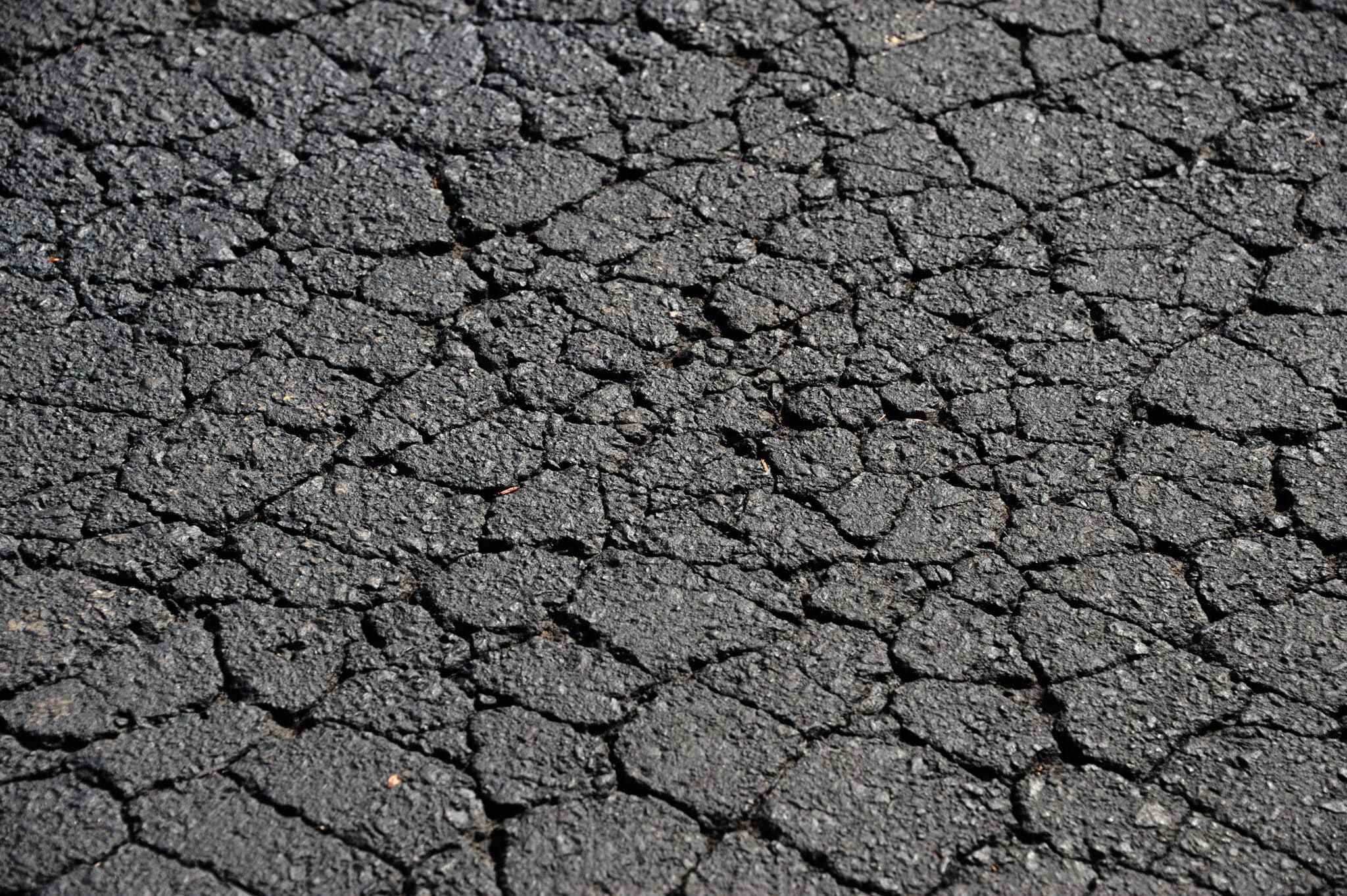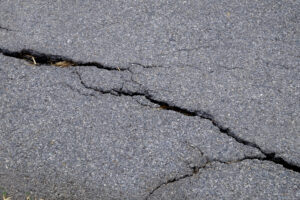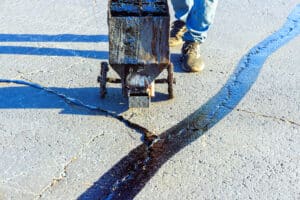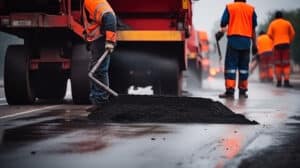Block cracking resembles a jigsaw puzzle on asphalt, with interconnected cracks forming rectangular patterns across the surface. If you’re a property owner, you’ve likely encountered this common type of pavement damage. Not only does block cracking affect the appearance of your asphalt, but it also weakens its structural integrity over time. Understanding what causes block cracking and how to fix it can help you extend the life of your pavement and prevent costly repairs. In this article, we’ll explore the main causes of block cracking and the best repair solutions to restore your asphalt.
Understanding Block Cracking
Block cracking, also known as alligator cracking or fatigue cracking, occurs on asphalt surfaces. It usually appears in areas with high traffic and heavy loads, such as parking lots, driveways, and roadways. Block cracks can range from 1-2 inches to several feet in length and are typically spaced closely together, giving the appearance of a shattered or fragmented surface. This damage is more common in older asphalt surfaces but can also occur on new pavement if not properly designed or installed.
Causes of Block Cracking
If you notice any block or alligator cracking on your property, it’s likely due to the following reasons:
Thermal Expansion and Contraction: As asphalt is exposed to the freeze-thaw cycle, it expands and contracts, causing stress on the surface. Over time, this repeated movement can lead to the development of block cracks.
Excessive Loading: Heavy vehicles or equipment passing over the same area repeatedly can put excess pressure on the pavement and cause it to crack. This is especially common in areas with high traffic or heavy vehicles.
Asphalt Fatigue: Asphalt has a lifespan and will eventually wear down and become brittle. As it ages, it becomes more prone to cracking, including block cracks. This is why regular maintenance and preventative measures are so important in extending the life of your pavement.
Poor Drainage: Standing water on the surface can weaken the asphalt and make it more prone to cracking. When water seeps into small cracks, it can freeze and expand, causing further damage.
Improper Installation or Manufacturing Defects: If the asphalt was not installed properly or there were defects in the manufacturing process, block cracking is more likely to pop up. Always work with a reputable and experienced contractor when dealing with an asphalt surface.
Seeing block cracking on your pavement can be frustrating, but it’s essential to address the issue as soon as possible. If left untreated, block cracks can lead to more serious damage and costly repairs down the line.
The Impact of Block Cracking on Pavements
Block cracking is not just unsightly; it can also impact your pavement’s overall health and longevity. When left untreated, block cracks can allow water and debris to seep into the underlying layers of the pavement, leading to worse damage. This can lead to potholes and even pavement failure.
Block cracks can also affect vehicle ride quality and pose pedestrian safety hazards. Uneven surfaces caused by block cracking can cause vehicles to swerve or lose control, leading to accidents. Pedestrians may also trip or stumble on bumpy pavement, causing potential injuries. If you are a property owner or manager, this could mean liability issues if someone gets injured on your pavement.
If you run a business on your property or plan to sell or rent it out, block cracking can also hurt curb appeal. A damaged pavement can give the impression of neglect and reduce the overall value of your property.
Repair Techniques for Block Cracking
The good news is that block cracking can be repaired with the proper techniques and materials. Here are some common methods used by paving professionals to address block cracking:
Crack Sealing: This involves filling the cracks with a rubberized sealant to prevent water and debris from entering. This is a great solution for these cracks and should be tried first in most cases. If the cracks are too wide, crack sealing may not be effective, and other methods may be needed.
Overlay or Resurfacing: A full overlay or resurfacing is the next option when the asphalt is too damaged to be repaired with crack sealing or patching. This involves placing a thin layer of asphalt on top of the existing pavement. Though this can be more cost effective, it’s only a temporary solution, as the cracks will eventually work their way through the new asphalt.
Patching: In cases where block cracks have caused significant damage, patching could be a suitable fix. This involves sawing and removing the damaged area, checking the base underneath to replace or compact as needed, and then applying and compacting new asphalt.
Complete Replacement: This is typically a last resort and should only be done if other repair methods are not possible. In this case, the asphalt surface is completely removed and replaced with new asphalt. While the most costly, this method can provide a brand new pavement surface that will last many years.
If you notice block cracking on your pavement, address it as soon as possible. If caught early, these cracks can often be fixed with crack sealing before they develop into larger and more expensive problems. Regular maintenance and inspections can also help prevent block cracking from affecting your property.
How to Prevent Block Cracking From Carving Up Your Pavement
As the saying goes, “Prevention is better than cure.” Here are some tips to prevent block cracking from occurring in the first place:
Proper installation: Hire reputable contractors to install and compact the asphalt correctly. This includes ensuring proper compaction and thickness of the asphalt layers. A bad installation can lead to premature cracking and damage.
Regular Cleaning: Keeping your pavement clean can help prevent debris and water from seeping into the cracks and causing damage. Regular sweeping and power washing can help keep your pavement in top condition.
Proper drainage: Standing water is one of the leading causes of block cracking. Make sure your pavement has adequate drainage systems in place to prevent water from pooling on the surface.
Sealcoating: Applying a sealcoat every 2-3 years can help protect your pavement from the damaging effects of UV rays and other elements. If your asphalt surface is new or just resurfaced, wait around six months before applying a sealcoat.
Regular inspections and Maintenance: Set up a schedule for regular inspections and stick to it. Catching signs of stress or minor damage early can lead to quick repairs that prevent long-term issues. Regular maintenance, such as crack sealing and pothole repairs, can also prevent block cracks from worsening.
Don’t wait until block cracking has already taken over your pavement before taking action. You can save time, money, and resources by being proactive instead of reactive. A well-maintained pavement not only looks better but also lasts longer.
Superior Asphalt Can Help Fix Block Cracking on Your Property
Block cracking or alligator cracking doesn’t have to spell disaster for your asphalt pavements. With the right knowledge and approach, you can effectively manage and repair block cracking, extending the lifespan of your pavement. If you are looking for professional help in fixing block cracking, Superior Asphalt has got you covered. We offer a variety of asphalt repair and maintenance services, including crack sealing and patching, to keep your pavement in top condition. Contact us today for a free quote!




